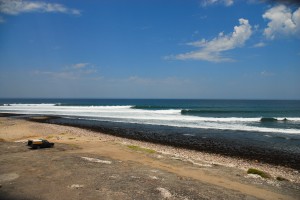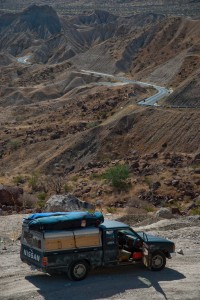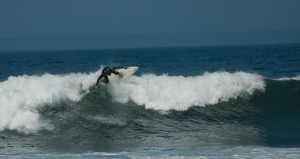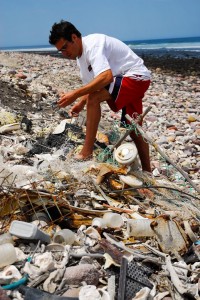 Baja California is a land of extremes – especially in the middle of summer.
Baja California is a land of extremes – especially in the middle of summer.
The desert is suffocating. At 6am, the heat begins to seep into being as soon as the sun crests the dry mountains and lights up the desert, by 9am heat mirages appear on the road horizon confusing drivers about company on the long highway, by 12pm trying to breathe the super heated air gives you the impression of being dried from the inside out. The ridges on Candelabra Cactus tell you all you need to know. It has not rained for a long time, and it is going to be a while yet before it rains again. They seem to be telling you a story: Conserve what you have, hunker down and wait it out.
Negotiating the dusty, empty dirt backroads of the Southern Baja in Wilfred, my $100 Nissan Kingcab pick-up, becomes unimaginable after 11am. All the windows are open, the “cold” air fan is max’ed out and still we are glued to the fake leather seats with sweat. The roar of the muffler-less tailpipe seems empty in this expanse, disturbing almost nothing in the drying landscape. We rattle the last few miles down to the point and park. Again, there is not another soul to be seen and the beach is empty.
While the land may be reaching boiling point, the water here is still cold – Very cold. Pulling on your thick black full-suit is made easier by the constant river of sweat escaping from your pores. Lubrication for the neoprene-skin interface. Standing on your boardbag – board underarm, wetsuit on – you plan your route to the water’s edge, to avoid areas of superheated sand and black rock. Once at the water’s edge, the contrast between your freezing, almost numb feet and your heat dehydrated cranium has you guessing which direction holds the lesser of two evils.
Once out in the line-up, we are accompanied by only by the locals: The numerous elephant seals that stalk the line-up and line the beach, and the multitudes of pelicans which ungracefully try to pluck fish from the impact zone, only to get clobbered by incoming sets. This results in us laughing so hard, that we almost lose our balance and fall into the frigid waters.
 The wave rears up from way around the point, always enticing you to paddle further and further out. Positioning is hard, but once you find the sweet spot, the wave wraps, bends, sections and throws all the way to the beach, hundreds of meters away. It takes all of your leg power just to keep pumping and riding the wave for that long. You really only need few of them to make your session a complete success.
The wave rears up from way around the point, always enticing you to paddle further and further out. Positioning is hard, but once you find the sweet spot, the wave wraps, bends, sections and throws all the way to the beach, hundreds of meters away. It takes all of your leg power just to keep pumping and riding the wave for that long. You really only need few of them to make your session a complete success.
While walking back up the beach you cannot help but be confronted with another issue. The beach is covered with plastic, metal and glass debris. The entire length of the beach berm is nothing more than a pile of discarded consumer crap. Lawn chairs, flip flops, snorkels, plastic beverage containers, engine blocks, Barbie dolls, you name it… Stuff that people didn’t take the time to get rid of properly and thought just leaving it lie, wasn’t such a big deal.
The point sticks way out into the Baja California Current , which runs southwards along  this coastline from American California. In fact, the current actually temporarily bends towards shore at this location which results in both the increased swell height but also the increased amount of plastic consumer crap on the beach. The Baja is the final resting place for much of American California’s trash due to the prevailing currents and winds, which blow and move predominantly south-east down the coast. So the lack of recycling action or intelligent thought by some individual in San Diego or San Francisco now has me carefully placing my feet between a Twinkie wrapper, a Monster Energy drink can and Barbie’s head. So despite the isolation of this particular point in the desert of the Baja and the lack of local population, the trash was piled high and constantly reminding us that our oceans connect all of us.
this coastline from American California. In fact, the current actually temporarily bends towards shore at this location which results in both the increased swell height but also the increased amount of plastic consumer crap on the beach. The Baja is the final resting place for much of American California’s trash due to the prevailing currents and winds, which blow and move predominantly south-east down the coast. So the lack of recycling action or intelligent thought by some individual in San Diego or San Francisco now has me carefully placing my feet between a Twinkie wrapper, a Monster Energy drink can and Barbie’s head. So despite the isolation of this particular point in the desert of the Baja and the lack of local population, the trash was piled high and constantly reminding us that our oceans connect all of us.
This phenomenon is world-wide. Trash from British Columbia, Canada often ends up on the beaches on California. Plastic junk from Japan often ends up on the empty northern beaches of Vancouver Island. We are all connected by the worlds’ currents and winds, so proverbial wing beats of a butterfly do in fact have huge affects far far way from the source. The axiom of “Think globally, Act locally” couldn’t be more fitting in the issue of marine debris. Be resourceful in Reducing, Reusing and Recycling and be safe in the knowledge that someone else’s beach suddenly has one less piece of pollution on it.
